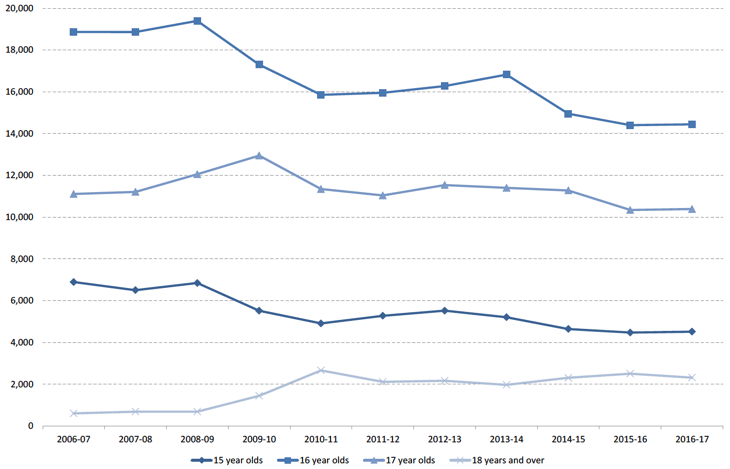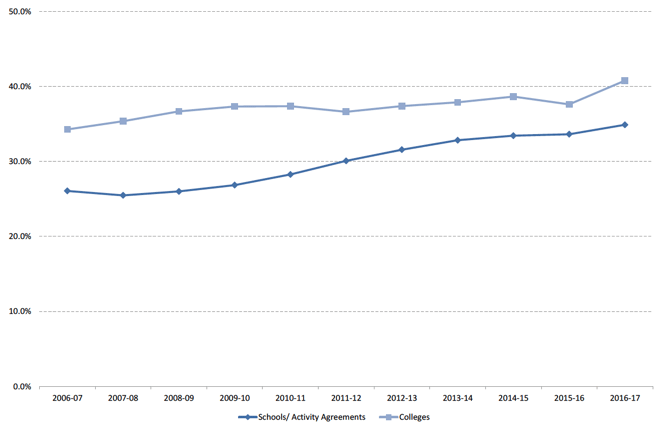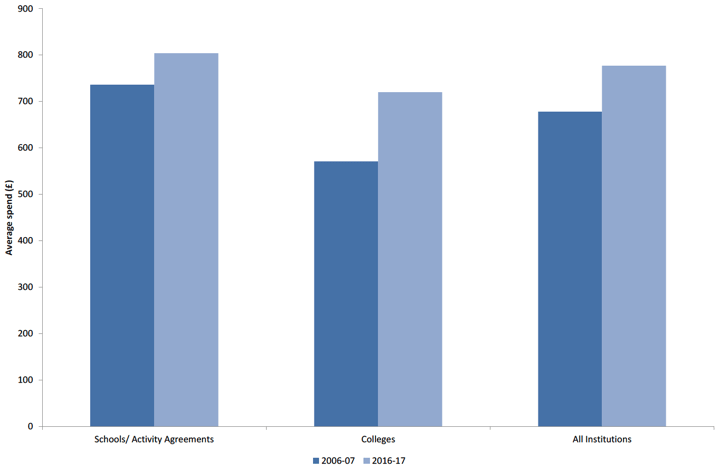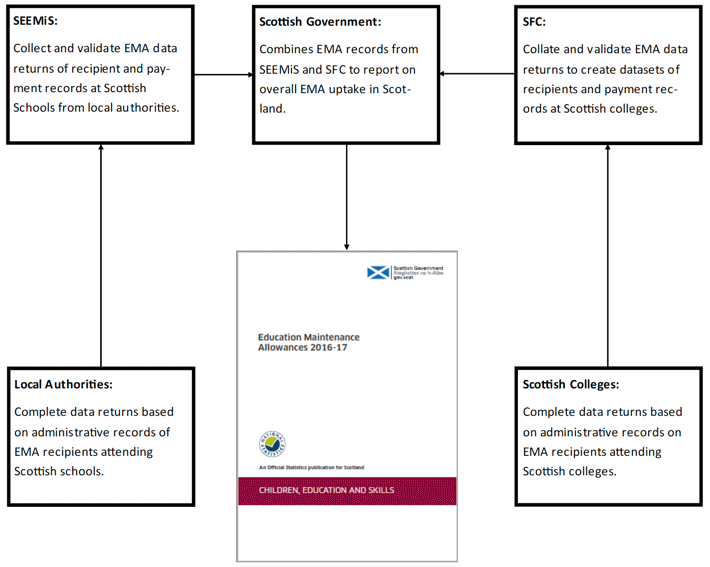Education maintenance allowances: 2016 to 2017
The Education Maintenance Allowances (EMA) programme aims to provide support for young people aged 16 to 19 from low income families to stay on in education.
This document is part of a collection
2. Analysis and Interpretation
Recipients of EMA
4. In 2016-17 there were 31,675 young people who received EMA payments, a slight decrease of 0.2% (-60) from 31,735 in 2015-16.
Figure 1: Young people in receipt of EMA by institution type, 2006-07 to 2016-17

5. Figure 1 shows how the number of people receiving EMA has changed over time. The overall total shows a decreasing trend in the number of claimants since 2006-07.
6. In 2016-17, School pupils accounted for 63.5% of young people in receipt of EMA payment, 32.2% were college students and the remaining 4.3% are young people on activity agreements ( Table 1).
7. Of all school pupils in Scotland aged 16 to 19 [1] , 29% received at least one EMA payment in 2016-17.
8. Of the potentially eligible full time college students [2] aged 16 to 19, 33% received at least one EMA payment in 2016-17.
Gender
9. In 2016-17, 49.2% (15,575) of EMA recipients were male and 50.8% (16,085) were female [3] .
10. Table 1 shows that the difference between the number of male and female EMA recipients. Over the years more females than males have claimed EMA each year, this difference between male and female recipients has decreased from 2,990 in 2006-07 to 510 in 2016-17.
Table 1: Young people in receipt of EMA by institution type and gender, 2006-07, 2015-16 and 2016-17
| Academic Year | Institution Type | Total | Male | Female |
|---|---|---|---|---|
| 2006-07 | Schools/ Activity Agreements | 24,430 | 11,485 | 12,945 |
| Colleges | 13,050 | 5,760 | 7,290 | |
| All Institutions | 37,480 | 17,245 | 20,235 | |
| 2015-16 | Schools/ Activity Agreements | 21,620 | 10,605 | 11,015 |
| Colleges | 10,115 | 4,895 | 5,220 | |
| All Institutions | 31,735 | 15,500 | 16,235 | |
| 2016-17 | Schools/ Activity Agreements | 21,470 | 10,575 | 10,895 |
| Colleges | 10,205 | 5,005 | 5,190 | |
| All Institutions | 31,675 | 15,575 | 16,085 |
Figures in this table have been rounded to the nearest 5.
See paragraph 3 for time series comparability.
Age
11. Figure 2 shows time series data for the different ages that receive EMA. Young people cannot receive EMA until they reach school leaving age. However, for data collection purposes, age is recorded on 30 th September each academic year, therefore there are some 15 year olds recorded as receiving EMA.
Figure 2: Young people in receipt of EMA by Age, 2006-07 to 2016-17

12. As in previous years, the majority of EMA recipients were 16 years old (14,445, 45.6%). 18 year olds and over make up the smallest proportion of EMA recipients (2,320, 7.3%) ( Table 2).
13. Since 2015-16 there has been an increase of 1.0% in the number of 15 year olds (45), an increase of 0.3% in the number of 16 year olds (40) and an increase of 0.4% in 17 year olds (45) receiving EMA. Conversely, there has been a decrease of 7.6% (-190) in the number of over 18 year olds claiming EMA, which is largely due to fewer college students claiming.
Table 2: Young people in receipt of EMA by deprivation and age, 2006-07, 2015-16 and 2016-17
| Academic Year | Deprivation Background | Age | ||||
|---|---|---|---|---|---|---|
| Total | 15 | 16 | 17 | 18+ | ||
| 2006-07 | Quintile 1 (Most Deprived) | 10,780 | 2,015 | 5,325 | 3,250 | 190 |
| Quintile 2 | 8,900 | 1,625 | 4,510 | 2,605 | 160 | |
| Quintile 3 | 7,565 | 1,415 | 3,790 | 2,250 | 110 | |
| Quintile 4 | 5,985 | 1,105 | 3,055 | 1,730 | 95 | |
| Quintile 5 (Least Deprived) | 4,015 | 695 | 2,060 | 1,220 | 45 | |
| All Areas | 37,480 | 6,895 | 18,870 | 11,110 | 605 | |
| 2015-16 | Quintile 1 (Most Deprived) | 11,015 | 1,570 | 4,980 | 3,600 | 865 |
| Quintile 2 | 7,950 | 1,100 | 3,590 | 2,550 | 710 | |
| Quintile 3 | 5,860 | 785 | 2,710 | 1,915 | 445 | |
| Quintile 4 | 4,320 | 640 | 1,930 | 1,450 | 295 | |
| Quintile 5 (Least Deprived) | 2,430 | 365 | 1,115 | 775 | 170 | |
| All Areas | 31,735 | 4,475 | 14,405 | 10,345 | 2,510 | |
| 2016-17 | Quintile 1 (Most Deprived) | 11,615 | 1,620 | 5,345 | 3,755 | 890 |
| Quintile 2 | 7,915 | 1,100 | 3,600 | 2,585 | 630 | |
| Quintile 3 | 5,630 | 830 | 2,565 | 1,865 | 375 | |
| Quintile 4 | 3,940 | 580 | 1,760 | 1,325 | 270 | |
| Quintile 5 (Least Deprived) | 2,470 | 375 | 1,120 | 835 | 145 | |
| All Areas | 31,675 | 4,520 | 14,445 | 10,390 | 2,320 | |
Figures in this table have been rounded to the nearest 5.
Deprivation
14. The proportion of EMA recipients living in Scotland's 20% most deprived areas in 2016-17 increased to 36.8% (11,615). This is an increase of 7.8 percentage points since 2006-07 ( Table 3). People from the 20% most deprived areas are therefore well represented among EMA recipients. This is partly explained by the fact that one of the main criterion for eligibility is household income, and income is a key domain in the Scottish Index of Multiple Deprivation [4] .
15. The actual number of EMA recipients living in Scotland's 20% most deprived areas in 2016-17 increased by 600, this is in contrast to the decrease seen in EMA recipients overall (60).
16. Figure 3 shows that the proportion of school pupils and those on activity agreements receiving EMA who live in the 20% most deprived areas increased over time. This proportion increased by 8.8 percentage points between 2006-07 and 2016-17 to 34.9%, compared to a 6.5 percentage point increase among college students over the same period, to 40.8%.
17. The proportion of college students receiving EMA who are from 20% most deprived areas has consistently been higher than the proportion for school pupils. This might be explained in part by the fact that people from the 20% most deprived areas in Scotland are generally over-represented in Scotland's colleges.
Figure 3: Percentage of young people in receipt of EMA that are from 20% most deprived areas by institution type, 2006-07 to 2016-17

Table 3: Young people in receipt of EMA by deprivation and institution type, 2006-07, 2015-16 and 2016-17
| Academic Year | Deprivation Background | All Institutions | Schools/ Activity Agreements | Colleges |
|---|---|---|---|---|
| 2006-07 | Quintile 1 (Most Deprived) | 10,780 | 6,320 | 4,460 |
| Quintile 2 | 8,900 | 5,505 | 3,400 | |
| Quintile 3 | 7,565 | 5,090 | 2,475 | |
| Quintile 4 | 5,985 | 4,240 | 1,750 | |
| Quintile 5 (Least Deprived) | 4,015 | 3,085 | 930 | |
| All Areas | 37,480 | 24,430 | 13,050 | |
| 2015-16 | Quintile 1 (Most Deprived) | 11,015 | 7,235 | 3,780 |
| Quintile 2 | 7,950 | 5,190 | 2,755 | |
| Quintile 3 | 5,860 | 4,055 | 1,805 | |
| Quintile 4 | 4,320 | 3,145 | 1,175 | |
| Quintile 5 (Least Deprived) | 2,430 | 1,890 | 535 | |
| All Areas | 31,735 | 21,620 | 10,115 | |
| 2016-17 | Quintile 1 (Most Deprived) | 11,615 | 7,460 | 4,155 |
| Quintile 2 | 7,915 | 5,230 | 2,685 | |
| Quintile 3 | 5,630 | 3,925 | 1,710 | |
| Quintile 4 | 3,940 | 2,840 | 1,095 | |
| Quintile 5 (Least Deprived) | 2,470 | 1,930 | 545 | |
| All Areas | 31,675 | 21,470 | 10,205 |
Figures in this table have been rounded to the nearest 5.
EMA Payments Total Spend on Payments
18. The EMA payment spend in 2016-17 was £24.6 million, a decrease of £137,855 from 2015-16. The decrease was driven by fewer school pupils and those on activity agreements claiming EMA (decreasing £112,020 from £17.4 million to £17.3 million), while the overall payment spend for college students continued to decrease over the same period, decreasing by £25,835.
19. The proportion of the EMA payment spend for school pupils and those on activity agreements in 2016-17 was 70.1%, the similar proportion as 2015-16 (Table 4).
Table 4: EMA spend (£) by institution type, 2006-07, 2015-16 and 2016-17
| Academic Year | Institution Type | Number of Recipients | Total (£) | Average Spend (£) |
|---|---|---|---|---|
| 2006-07*^ | Schools/ Activity Agreements | 24,430 | 22,923,580 | 736 |
| Colleges | 13,050 | 9,509,705 | 571 | |
| All Institutions | 37,480 | 32,433,285 | 678 | |
| 2015-16 | Schools/ Activity Agreements | 21,620 | 17,383,110 | 804 |
| Colleges | 10,115 | 7,376,865 | 729 | |
| All Institutions | 31,735 | 24,759,975 | 780 | |
| 2016-17 | Schools/ Activity Agreements | 21,470 | 17,271,090 | 804 |
| Colleges | 10,205 | 7,351,030 | 720 | |
| All Institutions | 31,675 | 24,622,120 | 777 |
Figures have been rounded to the nearest 5.
*Note: for 2006-07 academic year total (£) includes bonus payments. However, these bonus payments are excluded when calculating average spend.
20. The proportion of the EMA payment spends for each gender was 48.8% for males and 51.1% for females.
Table 5: EMA payment spend (£) by gender, 2006-07, 2015-16 and 2016-17
| Academic Year | Gender | Number of Recipients | Total (£) | Average Spend (£) |
|---|---|---|---|---|
| 2006-07*^ | Male | 17,245 | 14,847,315 | 676 |
| Female | 20,235 | 17,585,970 | 680 | |
| Total | 37,480 | 32,433,285 | 678 | |
| 2015-16 | Male | 15,500 | 12,009,195 | 775 |
| Female | 16,235 | 12,749,520 | 785 | |
| Total | 31,735 | 24,759,975 | 780 | |
| 2016-17 | Male | 15,575 | 12,020,460 | 772 |
| Female | 16,085 | 12,592,030 | 783 | |
| Total | 31,675 | 24,622,120 | 777 |
* Note: for 2006-07 academic year total (£) includes bonus payments. However, these bonus payments are excluded when calculating average spend.
Average Payment Spend per Person (excluding bonus payments)
21. Figure 4 charts the EMA programme's average annual payment spends per person. Average payment spend was calculated by dividing the total spend on weekly payments by the number of people who received an EMA payment each year. Bonus payments were excluded to allow comparisons with previous years' data, as bonus payments ceased in 2010-11.
Figure 4: Average EMA spend per claimant by institution type, 2006-07 and 2016-17

22. Figure 4 shows that the average EMA payment spends per person increased between 2006-07 and 2016-17.
23. Table 6 shows the differences in average spend between 2006-07 and 2016-17. The average payment in 2016-17 was £777 per person, showing an increase of 14.6% (£99) since 2006-07.
Table 6: Average EMA spend by institution type, 2006-07 and 2016-17
| Institution Type | 2006-07 | 2015-16 | 2016-17 | Change (£) since 2006-07 | Change (£) since 2015-16 |
|---|---|---|---|---|---|
| Average Payments (£) | Average Payments (£) | Average Payments (£) | |||
| School/ Activity Agreement | 736 | 804 | 804 | 68 | 0 |
| College | 571 | 729 | 720 | 149 | -9 |
| Total | 678 | 780 | 777 | 99 | -3 |
Note: for 2006-07 academic year bonus payments are excluded when calculating average spend.
24. One explanation for the increases in average payment is the removal of the £10 and £20 payment levels after 2008-09. Since all students now receive the maximum £30 weekly payments, the average spend per person would be expected to be higher in subsequent academic years.
25. Looking at the average payments by deprivation quintile, although those in the 20% most deprived areas make up the largest proportion of recipients they receive the lowest average payment of £760. This compares to those from the least deprived areas receiving average payments of £827.
Table 7: Average EMA spend by deprivation 2016-17
| SIMD 2016 | Number of Recipients | Total Payments (£) | Average Payments (£) |
|---|---|---|---|
| Quintile 1 (Most Deprived) | 11,615 | 8,828,860 | 760 |
| Quintile 2 | 7,915 | 6,117,210 | 773 |
| Quintile 3 | 5,630 | 4,427,760 | 786 |
| Quintile 4 | 3,940 | 3,141,540 | 797 |
| Quintile 5 (Least Deprived) | 2,470 | 2,043,750 | 827 |
| Total | 31,675 | 24,622,120 | 777 |
Impact of January 2016 policy extension
26. In January 2016 the EMA programme was extended, increasing the household income threshold for claimants under both schemes. This raised the threshold for households with one dependent child to £24,421 (from £20,351), and households with two or more dependent children to £26,884 (from £22,403). It also allowed students on non-advanced part-time college courses to claim EMA.
27. Additional analysis of the data was carried out to estimate the number of claimants from schools affected by the change in household income from January 2016. The analysis estimates that this EMA extension has impacted approximately 1,300 school pupils. These are students who previously would not have been eligible for EMA, but now are.
28. For an estimate of the impact the recent policy changes have had at colleges additional analysis will need to be carried out, however the number of recipients at college receiving EMA increased. This increase goes against the trend that has seen the number of recipients decreasing since the 2008-09 academic year.
Contact
There is a problem
Thanks for your feedback